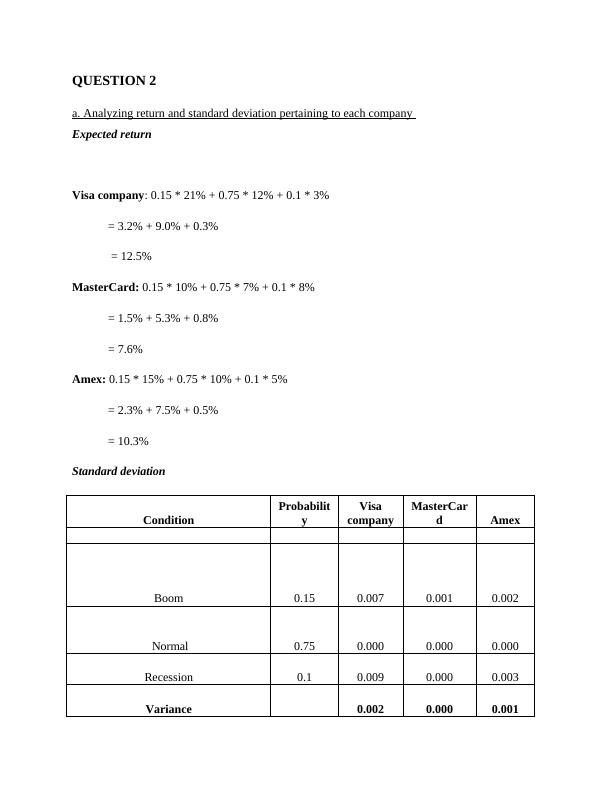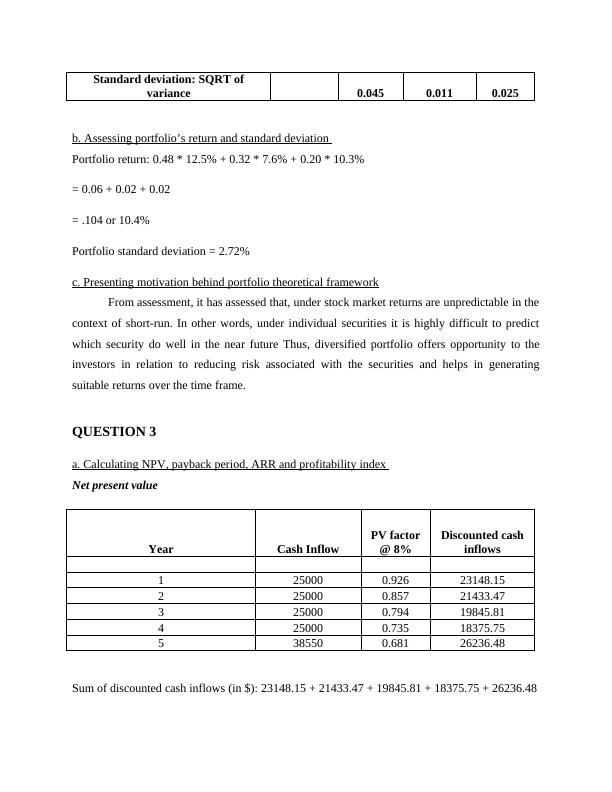Finance Questions Set 1 WACC Under Imputation Tax System Particulars Book Value After Tax Cost of Capital Long Term Debt
Added on 2020-10-22
14 Pages1986 Words372 Views
Finance Questions- Set 1

QUESTION 1
WACC under imputation tax system
Particulars Book Value After Tax Cost of Capital
Long Term Debt 20000000 7.80%
Ordinary equity 15000000 9.40%
Preference share capital 5000000 8.10%
Total 40000000
Corporation Tax Rate 30%
V 40000000
weight of equity 0.38
weight of preferred stock 0.13
Weight of Debt 0.50
cost of equity 9.40%
cost of preferred stock 8.10%
cost of debt 7.80%
Weighted average cost of capital (WACC) 7.4%
Stating the meaning of cost of capital and its role in investment decision making
Cost of capital presents minimum rate of return which company is expecting to earn from
a proposed project. In the context of decision making pertaining to investment project cost of
capital helps in evaluating viability. Thus, using WACC firm can assess whether proposed
investment will contribute in the organizational growth or not.
d. Stating reasons due to which cost of equity is always higher as compared to long and short
term debt
By doing evaluation, it has found that equity investors usually bear high risk over debt
holders. Thus, due to such aspect cost of equity is higher over debt.
WACC under imputation tax system
Particulars Book Value After Tax Cost of Capital
Long Term Debt 20000000 7.80%
Ordinary equity 15000000 9.40%
Preference share capital 5000000 8.10%
Total 40000000
Corporation Tax Rate 30%
V 40000000
weight of equity 0.38
weight of preferred stock 0.13
Weight of Debt 0.50
cost of equity 9.40%
cost of preferred stock 8.10%
cost of debt 7.80%
Weighted average cost of capital (WACC) 7.4%
Stating the meaning of cost of capital and its role in investment decision making
Cost of capital presents minimum rate of return which company is expecting to earn from
a proposed project. In the context of decision making pertaining to investment project cost of
capital helps in evaluating viability. Thus, using WACC firm can assess whether proposed
investment will contribute in the organizational growth or not.
d. Stating reasons due to which cost of equity is always higher as compared to long and short
term debt
By doing evaluation, it has found that equity investors usually bear high risk over debt
holders. Thus, due to such aspect cost of equity is higher over debt.

QUESTION 2
a. Analyzing return and standard deviation pertaining to each company
Expected return
Visa company: 0.15 * 21% + 0.75 * 12% + 0.1 * 3%
= 3.2% + 9.0% + 0.3%
= 12.5%
MasterCard: 0.15 * 10% + 0.75 * 7% + 0.1 * 8%
= 1.5% + 5.3% + 0.8%
= 7.6%
Amex: 0.15 * 15% + 0.75 * 10% + 0.1 * 5%
= 2.3% + 7.5% + 0.5%
= 10.3%
Standard deviation
Condition
Probabilit
y
Visa
company
MasterCar
d Amex
Boom 0.15 0.007 0.001 0.002
Normal 0.75 0.000 0.000 0.000
Recession 0.1 0.009 0.000 0.003
Variance 0.002 0.000 0.001
a. Analyzing return and standard deviation pertaining to each company
Expected return
Visa company: 0.15 * 21% + 0.75 * 12% + 0.1 * 3%
= 3.2% + 9.0% + 0.3%
= 12.5%
MasterCard: 0.15 * 10% + 0.75 * 7% + 0.1 * 8%
= 1.5% + 5.3% + 0.8%
= 7.6%
Amex: 0.15 * 15% + 0.75 * 10% + 0.1 * 5%
= 2.3% + 7.5% + 0.5%
= 10.3%
Standard deviation
Condition
Probabilit
y
Visa
company
MasterCar
d Amex
Boom 0.15 0.007 0.001 0.002
Normal 0.75 0.000 0.000 0.000
Recession 0.1 0.009 0.000 0.003
Variance 0.002 0.000 0.001

Standard deviation: SQRT of
variance 0.045 0.011 0.025
b. Assessing portfolio’s return and standard deviation
Portfolio return: 0.48 * 12.5% + 0.32 * 7.6% + 0.20 * 10.3%
= 0.06 + 0.02 + 0.02
= .104 or 10.4%
Portfolio standard deviation = 2.72%
c. Presenting motivation behind portfolio theoretical framework
From assessment, it has assessed that, under stock market returns are unpredictable in the
context of short-run. In other words, under individual securities it is highly difficult to predict
which security do well in the near future Thus, diversified portfolio offers opportunity to the
investors in relation to reducing risk associated with the securities and helps in generating
suitable returns over the time frame.
QUESTION 3
a. Calculating NPV, payback period, ARR and profitability index
Net present value
Year Cash Inflow
PV factor
@ 8%
Discounted cash
inflows
1 25000 0.926 23148.15
2 25000 0.857 21433.47
3 25000 0.794 19845.81
4 25000 0.735 18375.75
5 38550 0.681 26236.48
Sum of discounted cash inflows (in $): 23148.15 + 21433.47 + 19845.81 + 18375.75 + 26236.48
variance 0.045 0.011 0.025
b. Assessing portfolio’s return and standard deviation
Portfolio return: 0.48 * 12.5% + 0.32 * 7.6% + 0.20 * 10.3%
= 0.06 + 0.02 + 0.02
= .104 or 10.4%
Portfolio standard deviation = 2.72%
c. Presenting motivation behind portfolio theoretical framework
From assessment, it has assessed that, under stock market returns are unpredictable in the
context of short-run. In other words, under individual securities it is highly difficult to predict
which security do well in the near future Thus, diversified portfolio offers opportunity to the
investors in relation to reducing risk associated with the securities and helps in generating
suitable returns over the time frame.
QUESTION 3
a. Calculating NPV, payback period, ARR and profitability index
Net present value
Year Cash Inflow
PV factor
@ 8%
Discounted cash
inflows
1 25000 0.926 23148.15
2 25000 0.857 21433.47
3 25000 0.794 19845.81
4 25000 0.735 18375.75
5 38550 0.681 26236.48
Sum of discounted cash inflows (in $): 23148.15 + 21433.47 + 19845.81 + 18375.75 + 26236.48

End of preview
Want to access all the pages? Upload your documents or become a member.
